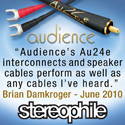|
|
You are reading the older HTML site
Positive Feedback ISSUE 62
polk audio LSIM707 Reference Loudspeakers as reviewed by Pete Davey
Let me ask you a question, what do you think about when you hear Polk audio? Be honest with me here… I'll share my answer with you, I think about home theatre speakers that I've seen in Circuit City, Best buy, Good Guys (remember them)? Not that there's any negative connotation with those big boy retailers, well what's left of them anyway. It's just that, you typically put them in the mediocre category when it comes to two channel music playback devices. Hell, I have had a pair of dipole Polks in my movie room for quite some time, and they've never given me any issues, they sound great and were very affordable. To say I was surprised when Polk wanted to send out a pair of their flagship speakers for review to a high end audio magazine would be an understatement, but I took it as a challenge! Why not? I mean, I started to look up some of the data and specifications on them and started to second guess my thoughts. More on that later… It wasn't long before the speakers showed up, and I was taken aback by the sheer size and weight of the boxes. They were delivered on a crate / pallet and, immediately my whole world view changed when it came to Polk Audio. No joking around here, 115 lbs a piece, double walled cardboard, I could not wait to get these out of their boxes to see what was in store for me (and my neighbors). Immediately I was blown away from what I saw out of the box, beautiful cherry cabinets (they refer to it as "Mount Vernon Cherry" with some really state of the art drivers. Akin to a (three times as expensive) Sonus Faber speaker, it was love at first sight. The grille is held on by magnets! Genius… After getting them out of their boxes and putting them in their respective new homes, I started to notice even more attention to detail—bi-wire capabilities (with a very nice set of jumpers included), and adjustable front AND back angling. While these are menacing in their boxes, they are quite sexy in the flesh— very smooth appearance, reminds me of an airflow bench designed airplane wing. These things are really something else! What I didn't know was that the woofers on the bottom of the speaker were also ported on the bottom, separated by the plinths.
You may know that I am smitten with an open sound; dipoles are my thing—especially natural ones such as ribbons / electrostats, and the like. The thing that is always missing though is that thumpy deep bass that most box speakers have in spades. The quest to find a speaker that exhibits both characteristics of sound has still gone unfound, but I will say that these speakers get it very close. I at first set them up exactly where my Apogee Scintillas used to live and connected them via bi-wire to my Plinius SA-250 (gobs of power) and warmed up the system. The first album I put on was James Blake (surprise!). This now well-known audio gem of an artist is usually my immediate first album to play when new equipment comes in. There's just something about its crisp heartfelt haunting sound (even more so on the vinyl edition of the self-titled album) that really gets things going. Right off the bat I heard powerful (almost too powerful) bass-lines, amazing silky smooth highs, and dead-on mids. I sunk down into my listening chair and my jaw dropped. I could not believe the imaging, timbre, and rhythm coming from such a speaker. Man—it was really nice to have a very soft, warm inviting sounding system with such authoritative bass!
After throwing on about 20 other records, and spending hours upon hours of listening to some of my favorites all over again, my tweak geek came out and I thought about playing around with positioning and the height. The nice thing with boxed speakers that have ports on the bottom is that you can get them pretty close to the rear wall with no detrimental effects that you would get with an open dipole, as you may all already know. Reading up on the specs for these speakers really starts to align the stars, so-to-speak. The sides are made of 1" MDF (probably why they weigh so much!) and the rear baffle is ¾". Each driver has its own internal baffle as well to keep transients where they belong. The crossovers are really magical here—called an Orth design where it maintains a low order (best sounding in my opinion) but provides the efficiency of a higher order slope. The cohesion of sound between all of the drivers remained seamless, a really great sounding effort. Here's a shot of the inner-chambers:
This is a picture of the oval (6x9) driver providing the low frequency duties. An interesting design that's been around for dozens of years and primarily used in the car audio market, big size / low space requirements allowing this speaker to remain a bit on the skinny side:
Here's a close-up shot of the internal bracing and one of the crossover networks:
Here's a shot of the internal speaker with all crossover networks visible:
All in all, I believe these speakers remain a viable choice in the high end audio world, and should not be ignored if one is shopping for a great priced, high end speaker backed by a company that has been making speakers for a lot longer than most boutique speaker designers on the market today. If I had the choice, I'd seriously consider these as great contenders to replacing my Apogees, if I had to find a replacement. Pete Davey
LSIM707 Reference Loudspeakers
Polk Audio
|














